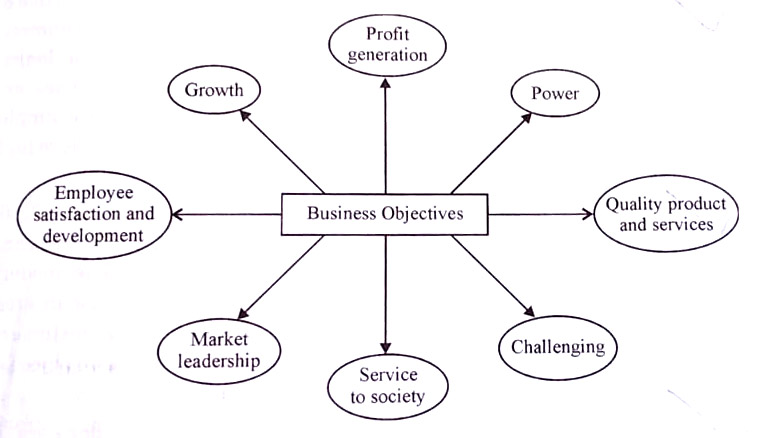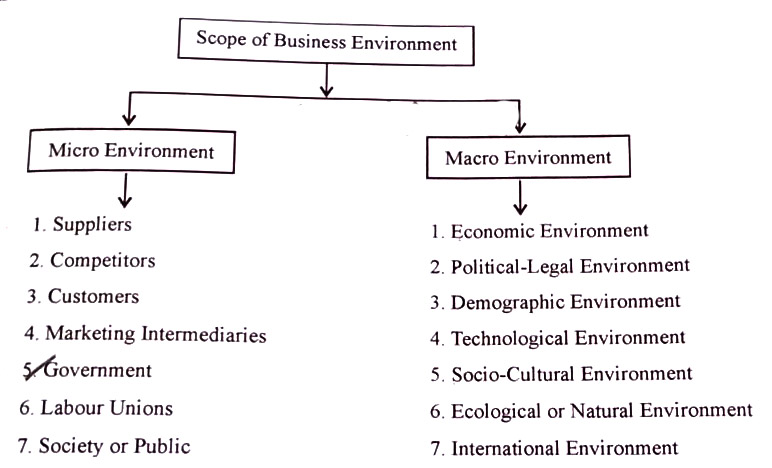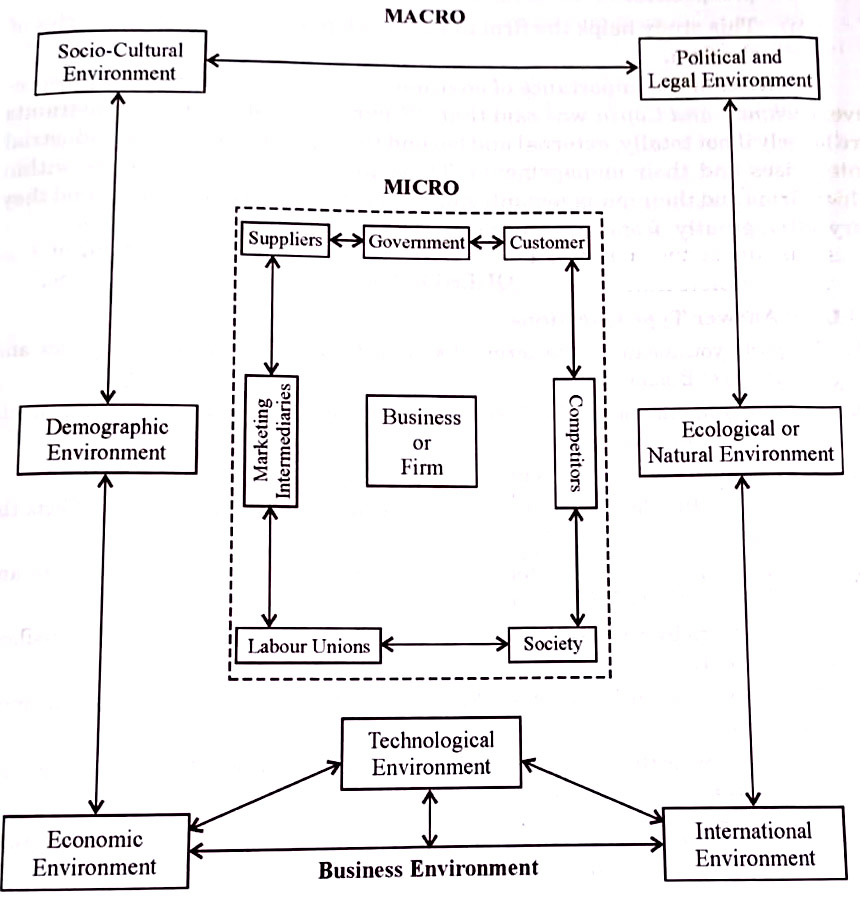BCom Business and Business Environment Notes Study Material
BCom Business and Business Environment Notes Study Material: We provide to all the students of BCom. BCom 1st, 2nd, and 3rd Year Business Environment Notes Study material, question answers, sample papers, mock test papers, and pdf. At gurujistudy.com you can easily get all these study materials and notes for free. Here in this post, we are happy to provide you with BCom 1st Year Business and Business Environment Notes Study Material.

BCom Business and Business Environment Notes Study Material
Every Business enterprise has continuous interaction with environmental forces. It has a direct relation with its environment. Environment refers to tome all external forces, which have a bearing on the functioning of a Business. The environment includes all those factors which can lead to opportunities for or threats to the firm. Obviously, the effectiveness or interaction of an enterprise with its environment primarily determines the success or failure of a business:
MEANING OF BUSINESS
Business is an economic activity. Economic activity is the task of adjusting the resources to ends (targets). Basically, there are two types of activities—Economic and Non-economic activities. Economic activities are related to those activities, which facilitate the production, distribution, and exchange of goods and services. But Non-economic activities are related to human sentiments or emotions like religion, patriotism, charity, etc. (BCom Business and Business Environment Notes Study Material)
DEFINITIONS OF BUSINESS
The term ‘Business’ is defined by various authors differently:
(i) “Business may be defined as a human activity directed towards production or acquisition of wealth through buying and selling of goods” -L.H. Haney
(ii) “Business comprises all profit-seeking activities and enterprises that provide goods and services necessary to an economic system.” -Boone and Kurtz
(iii) “Business may be defined as the organized effort by individuals to produce goods and services, to sell these goods and services in a marketplace and to reap some reward for this effort.” –Davis Keith
(iv) “The term business means exchange of goods, money or services for mutual benefits.”
On the basis of the above definitions, we may define business as an economic activity that involves the production or purchase and sale, transfer, or exchange of goods and services at a profit through the satisfaction of human needs. Profit maximization is the prime objective of a business but we can’t ignore the social responsibility of business towards customers, society, and the nation.
FEATURES OF BUSINESS
The business has the following important features:
(i) Provision of goods and services to society.
(ii) Business activities are directly or indirectly, concerned with the sale, transfer, or exchange of goods and services for the satisfaction of human needs or wants.
(iii) Business activities are continuous activities.
(iv) It is economic activity related to the transformation of goods or services.
(v) Profit is the prime motive of any business.
(vi) Risks or uncertainties may be happening in the business.
In the modern age, the expectations of society for business is increased. Customer satisfaction is the prime motive of business instead of profit maximization for survival in the long run. According to Peter F. Drucker, the objective of business is, to create a customer and to expand the market share of the business.” In totality, it says that. Business is the creation of society and its final objective is to fulfill the needs of society. (BCom Business and Business Environment Notes Study Material)
OBJECTIVES OF BUSINESS
A business unit has many common objectives are explained below:

(i) Profit Generation: Profit generation is the primary objective of any business organization. It is a surplus of income over expenses for expansion, growth, and survival of any business in the long run. It is a strong sustainer and motivator of business activities.
(ii) Growth: Growth is the second primary objective of business enterprises. An enterprise can’t sustain itself for a long time without the adoption of growth policies. These strategies are increasing market share, adding more products, exploring new markets, cost reduction with an increase in productivity, diversifying into new areas, etc.
(iii) Power: For the expansion of business ventures economic and political power must be required. Business confers enormous power on owners and endows them with vast resources. Business executives or big business houses make and unmake political parties and political leaders.
(iv) Employee Satisfaction and Development: To provide employee satisfaction with their development has been one of the objectives of business enterprises. A satisfied employee is precious for any business. For example, the Aditya Birla group is a legend in pursuing this objective. It facilitates safety and security measures, family welfare training and development facilities, etc. to make satisfied and devoted employees.
(v) Market Leadership: To be a market leader is another important objective of the business. In the age of cut-throat competition, it is very difficult to be a market leader among various firms. Through quality products, innovation, cost reduction, quick supply, and after sale-service a firm can be a leader or apex among others. (BCom Business and Business Environment Notes Study Material)
(vi) Quality Products and Services: One of the important objectives of the business is to provide quality products and services to customers. On the behalf of good quality, a business can survive for a longer duration in business life. Big brands or big business houses are flourishing mainly because of the quality of its product. For example, Rin, Surf, Lux, Liril, Rexona, Pears, etc. are brands, that produce high-quality and reasonable products for buyers. (BCom Business and Business Environment Notes Study Material)
(vii) Service to Society: The customer is a part of society. Profit maximization is the prime objective of business but a business can’t ignore social responsibility and the wellness of society. The modern outlook of business is that the business should not serve the interest of business alone, but also take care of the interests of customers, employees, nation, and society. Service to society is the main objective of a non-profit making enterprise.
(viii) Challenging: Business has risks or uncertainties in the modern era. In the initial stage, there are risks for survival and acceptance among buyers and other competitors of the business. Business units have big challenges with fund generation and technological changes.
In the past era, the exclusive objective of business was profit maximization. They totally ignored the social responsibility of business. In the modern era, the objective of any business is to achieve profit maximization through customers’ satisfaction and the welfare of society. According to Peter F. Drucker, the prime objective of business is “To create a customer and expand the market share of the business.” Finally, we can say that in the modern age a business cannot isolate itself from the rest of society.
CONCEPT OF BUSINESS ENVIRONMENT
Environment refers to surrounding external objects and influences of circumstances under which an organization is expected to exist. The environment is the aggregate of all conditions, events, and influences that surround and affect the organization. Davis Keith defines the environment of business as “the aggregate of all conditions, events, and influences that surround and affect it.”
Every business organization has to interact and transact with its environment. Hence, the business environment has a direct relationship with the business. Obviously then, the effectiveness of interaction of an enterprise with its environment primarily determines the success or failure of a business.
There are two types of environmental factors-internal and external – which influence the business policy of an organization. The internal factors are known as controllable factors because the organization has control over these factors. The external factors are known as uncontrollable factors because such factors are beyond the control of the organization.
DEFINITIONS OF BUSINESS ENVIRONMENT
Some definitions of business environment which help to know about the business environment as below:
(i) According to Philip Kotler: “A company’s environment consists of factors and forces that are external to the business management function of the firm, and that impinge on the management’s ability to develop and maintain successful transactions with its customers.”
(ii) According to Andrews: “The term business environment of a company is defined as the pattern of all external influences that affect its life and development.”
(iii) “Business environment consist of all external and internal factors that influence the complex interaction of the market, production, and finance—the three basic components of the business world.” –J.A. Kritz and C.T. Duggan
(iv) “An organization’s external environment, consists of those things outside an organization such as customers, competitors, Government, suppliers, financial firms and labor pools that are relevant to an organization’s operations.” -Prof. Gerald Bell
On the basis of the above definitions, we can say that a business environment is a set of external and internal forces like social, economic, political, and technological forces that are largely outside the control and influence of a business, and that can have a positive and negative impact of the business. (BCom Business and Business Environment Notes Study Material)
FEATURES OF BUSINESS ENVIRONMENT
On the basis of aforesaid concept and definitions we can say that business environment contains some important features as below:
(i) Dynamic in Nature: The business environment is a composition of all external and internal conditions which are dynamic in nature. External factors like market, political, legal, cultural, technological, etc. are dynamic in nature and change occurs frequently among them. However, some environmental factors such as economic, technological, and competitive are changing faster than the other environmental factors.
(ii) Business Environment is Complex: It is also complex in nature. It is an aggregation of various external and internal factors like economic, political-legal, socio-economic, technological, etc., which makes it complex. These elements affect the business in different ways. Therefore we can’t survive in business for a long time without pre-exercise about the effects of these factors. The complexity and Dynamic nature of products make it difficult to predict the future. (BCom Business and Business Environment Notes Study Material)
According to J.A. Kritz and C.T. Duggan, “Business Environment consists of all external and internal factors that influence the complex interaction of the market, production, and finance—the three basic components of the business world.”
(iii) Set of Internal and External Environment: The business environment consists of two types of factors: External and Internal. The Internal factors are generally controllable factors. These are technical and physical facilities, organizational policies, financial capabilities, personnel capabilities, etc. The external environmental factors are uncontrollable these factors like economic political and legal, social and cultural, technological, ecological or natural, etc. have a major effect on the functioning of the business enterprise. Hence, these factors are to be carefully tackled because they facilitate information about opportunities and threats of the enterprise.
(iv) Multi-dimensional: Business environmental is a set of economical, technological, social, and political forces, that are largely outside control and they affect the business positively as an opportunity and negatively as threats. External factors incorporate all the factors which are outside the organization and influence the ability to achieve organizational goals through providing opportunities or posing threats to the organization. In other words, a business environment is multi-dimensional and governed by the organizational control process to achieve its goals and objectives. (BCom Business and Business Environment Notes Study Material)
(v) Totality of Uncertain Factors: In the fast-moving modern era. It is very difficult to predict future happenings when environmental changes are taking place very quickly. All external factors are uncertain, which affect the organization and operations of the business.
SCOPE OF BUSINESS ENVIRONMENT
The business environment is dynamic. There is a continuous change in its components and elements. Generally, the business environment is composed of two types of factors: internal factors and external factors. Internal factors include all those forces, which are inside the organization and directly affect the activities and performance of the organization.
External environmental forces combine all the factors which are outside the organization and affect the business operations from its outer variable like customers, suppliers, competitors, financial intermediaries, policies, etc. Generally, internal factors are controllable factors and an organization has to control these factors and adjust the situation as per its requirements. But external factors are uncontrollable and beyond the control of the organization. We can broadly classify these external factors into micro-environmental factors and macro-environmental factors. (BCom Business and Business Environment Notes Study Material)
The microenvironment comprises the resources, synergy, and distinctive competencies of a firm. These together determine its organizational capability in terms of its strengths and weaknesses existing in the different functional areas-marketing, operations, personnel, financial, technical, etc.
The Macro environment consists of all those forces, that are beyond the control of the firm and the success of the firm will depend to a large extent on its adaptability to the environment. These macro-level factors are social, economic, political, demographic, technological, etc. we can explain various components of the micro and macro environment with help of the following chart and explanation in detail:

MICROENVIRONMENT
- Suppliers: Suppliers ensure regular supply of inputs (raw materials and other components) to the company. In an organization, the managerial people of the company wish to obtain raw materials at the lowest possible price. It is possible when our suppliers are reliable. A good working relationship with suppliers can also help an organization serve its customers.
- Competitors: A company or a business enterprise decides its future strategies as per the competitive environment of the business to overcome its threats. The organization should know about competitors’ planning in the area of the product, pricing, customer service, advertising, packing, etc. The business organization must have information about customers in order to provide customer satisfaction through better services.
- Customers: Customer is a prime factor in any business environment. Customer feedback is essential to keep and maintain our regular customers and to attract new customers. According to Waterman Rober & Harper & Raw, “Customers are not homogeneous group, organizations need to stay close to their customers to understand their needs and wants and how these change over time.”
So, monitoring the customer’s behavior is a prerequisite for the success of any business. There are different types of customers and business organization is required to produce goods and services as per their requirements These customers are individual and household customers, commercial customers-whole sale and retail customers, Government bodies, foreign customers, etc. - Marketing Intermediaries: Marketing intermediaries include services of transport, warehouses, C&F agents, merchandising agencies, marketing service agencies, advertising agencies, and other financial intermediaries, etc., to help the organization for smooth selling and distribution of goods and services to customers. The business organization must have effective coordination among these marketing intermediaries for profit maximization and intensive sales. (BCom Business and Business Environment Notes Study Material)
- Government: Our government makes regulations or frameworks for business activities. A business must have to follow this regulation and decides on all business activities in accordance with the regulatory framework. For example, the high cost of licensing fees enforces to the reduction of new business activities. (BCom Business and Business Environment Notes Study Material)
- Labour Unions: Labour unions can be a great influence on the supply of the labor force. Labour Unions always resist the adoption of new machines against labor, wage reduction, labor retrenchment, etc. to protect labor. So that the management always takes cooperative and negotiating steps with them for solving labor problems like wages, working hours, medical facilities, etc.
- Society: The customer is a part of society and society has different cultures, religions, traditions, and systems. These elements have a great influence on business activities. A marketer can’t ignore these facts and interests for the ultimate satisfaction of group’s wants or desires.
MACRO ENVIRONMENT
(i) Economic Environment: The economic environment is made up of macro-level factors related to the area of production and distribution of wealth that affect the business of an organization. An economic environment of a business depends upon some important factors listed below:
(a) The economic structure that is adopted by a country as capitalistic, socialistic, or mixed economy.
(b) Economic Strategy that exists at a given time in a country.
(c) Economic planning such as 5 years of planning, an Annual budget, etc.
(d) Economic policies—Monetary, Industrial, Fiscal, etc.
(e) Economic indicators such as per capita income, GDP, National income, rate of growth and growth of GNP, distribution of income, rate of saving, the balance of payment, etc.
Business managers are totally aware of all those factors which directly affect their organization and business.
(ii) Political-Legal Environment: Political environmental factors refer to the factors which are related to the management of public affairs and their impact on the business of an organization. It is closely related to the economic system and economic policy.
In most countries, a number of laws regulate the conduct of a business. The Government of India has an all-pervasive and restrictive influence over the various aspects of business in the country. For example, Govt. of India restricts the concentration of economic power through industrial licensing; the MRTP act against monopolistic trade practices; the special privileges to the small-scale sectors, etc.
India is a democratic country with a stable political system. The elected government plays an effective role as a planner, promoter, and regulator of the economic activity of the business. (BCom Business and Business Environment Notes Study Material)
(iii) Demographic Environment: Demographic factors includes the size, growth, age composition, sex composition, etc. of the population in the country. They also include family size, educational levels, language, religion, caste, etc. The demand for goods and services is affected by demographic factors such as the size of the population, population growth rate, age, sex composition, life expectancy, family size, employment pattern, etc.
A rapidly increasing population, however, leads to the growing demand for many products. A high population growth rate also indicates an enormous increase in the supply of labor. For example, western countries faced the problem of labor shortage which encouraged the growth of labor-saving technologies and automation. However, most developing countries are facing a population explosion and a situation of labor surplus. Therefore, labor-intensive methods of production are encouraged by the governments of developing countries.
(iv) Technological Environment: Technology is considered to be one of the most important factors in any business environment. The technological environment comprises those factors related to applied knowledge and the materials and machines used in the production of goods and services. The way production function is organized; the way products are marketed; the way employees are hired and motivated; the way finance function is carried on, and the way managers and subordinates communicated with each other—all are influenced by technology.
Technology is the knowledge of new techniques or methods that improves our production and distribution of goods and services. It facilitates greater output, shorter working hours, development of skills in jobs, safer working conditions, efficient use of materials and labor, standard quality products, etc. (BCom Business and Business Environment Notes Study Material)
There are some important factors and influences operating in the technological environment:
(a) Sources of technology, cost of acquisition of technology, collaboration in and transfer of technology.
(b) Technological development and research & development
(c) Impact of technology on human beings and the effect of technology on the environment.
(d) Communication etc.
(v) Socio-Cultural Environment: Every business operates within the norms of society and exists primarily to satisfy its needs. Social factors influence the policy and strategy of the business, the organization strives to satisfy the needs and wants of society. These factors are culture, values, tastes and preferences, social integration, etc. Cultural norms largely drive consumer needs and buyer behavior. Knowledge of the cultural environment is important to understand the business environment in its totality.
Cultural and social environmental awareness and analysis help to pinpoint market opportunities. For example, the early failure of Kelloggs’ in India is due to its lack of understanding the Indian taste preference. Earlier, Kellogg’s was positioning its product for the entire family. But Indian ideally consists of breakfast of Idli-sambar, Dosa, Dal-roti, Sabji-Roti, Paratha, etc. Cornflakes as breakfast are perceived more as a westernized taste. So, Kellogg’s failed in India This has forced the company to now position their product for children as a source of complete nutrition and good health like “Kellogg’s chocoes” in chocolate flavor, especially for children.
It is therefore imperative to gather a deep understanding of cultural differences and grasp the intricacy of the foreign markets in this era of Globalization when even the geographical boundaries are crashing.
(vi) Ecological Environment: Ecology consists of the study of nature, and biotic factors—water, air, sunlight, soil, plants, animals, and other microorganisms and their interactions with one another. Man is expected to preserve the ecological factors for achieving sustainable growth. Changing any biotic factors causes ecological imbalance. (BCom Business and Business Environment Notes Study Material)
Industrial activities, automobiles, emission of fumes or smoke and effluents, and so on result in environmental degradation. Hence, Environmental protection and preservation must be the responsibility of every organization or individual. So, pollution-free industrial activity is, considered to be necessary for industrial organizations and big business houses. The government of India is committed to the preservation of ecological balance through various legislation as below:
(a) The Water (Preservation and Control of Pollution) Act, 1974.
(b) The Air (Preservation and Control of Pollution) Act, 1981.
(c) The Environmental (Protection) Act, 1986, etc.
(vii) International Environment: After economic reform, businesses are now compelled to come out of their domains and see beyond the physical boundaries of the country. There is a need for a universal rule of business from a global perspective. In the new scenario, the aim of business is to reduce the gap between domestic prices and world prices and lower the trade barriers-tariff and liberalize the trade regime through the adoption of Liberalization, Privatisation, and Globalization for the development of business.
In pursuance of this broad objective, the World Trade Organisation (WTO), General Agreements on Trade in Services (GATS), the agreement on Trade-Related Aspects of Intellectual Property Rights (TRIPs), and the agreement on Trade-Related Investment Measures (TRIMs) have been brought as a universal rule of business. (BCom Business and Business Environment Notes Study Material)
The factors of micro and macro environment are illustrated with the help of the Business Environment Model as given below:

IMPORTANCE OF THE STUDY OF BUSINESS ENVIRONMENT
The benefits of environmental study may be specified as below:
(i) This study helps the firm in the development of broad strategies and long-term policies of the firm.
(ii) To make aware of technological advancement.
(iii) This study should help the management in analyzing the competitor’s strategies and planning.
(iv) It provides a rich source of ideas and understanding about political changes taking place in the environment.
(v) It helps to know about socio-economic changes at the national and International levels on the firm’s stability.
(vi) The study of the environment should provide inputs for strategic decision-making in respect of the International Environment and perspective.
(vii) This study helps the firm in the development of long-term policies of the firm.
In favor of the importance of environmental analysis from a modern prospective, Richman and Copen said that, “Environmental factors or constraints are large if not totally, external and beyond the control of individual industrial enterprises and their managements. These are essentially the givers within which firms and their managements must operate in a specific country and they are very, often greatly, from country to country.” (BCom Business and Business Environment Notes Study Material)
BCom 1st Year Business and Business Environment Notes Study Material
Bcom 1st Year Sample Model Practice Mock Test Question Answer Papers